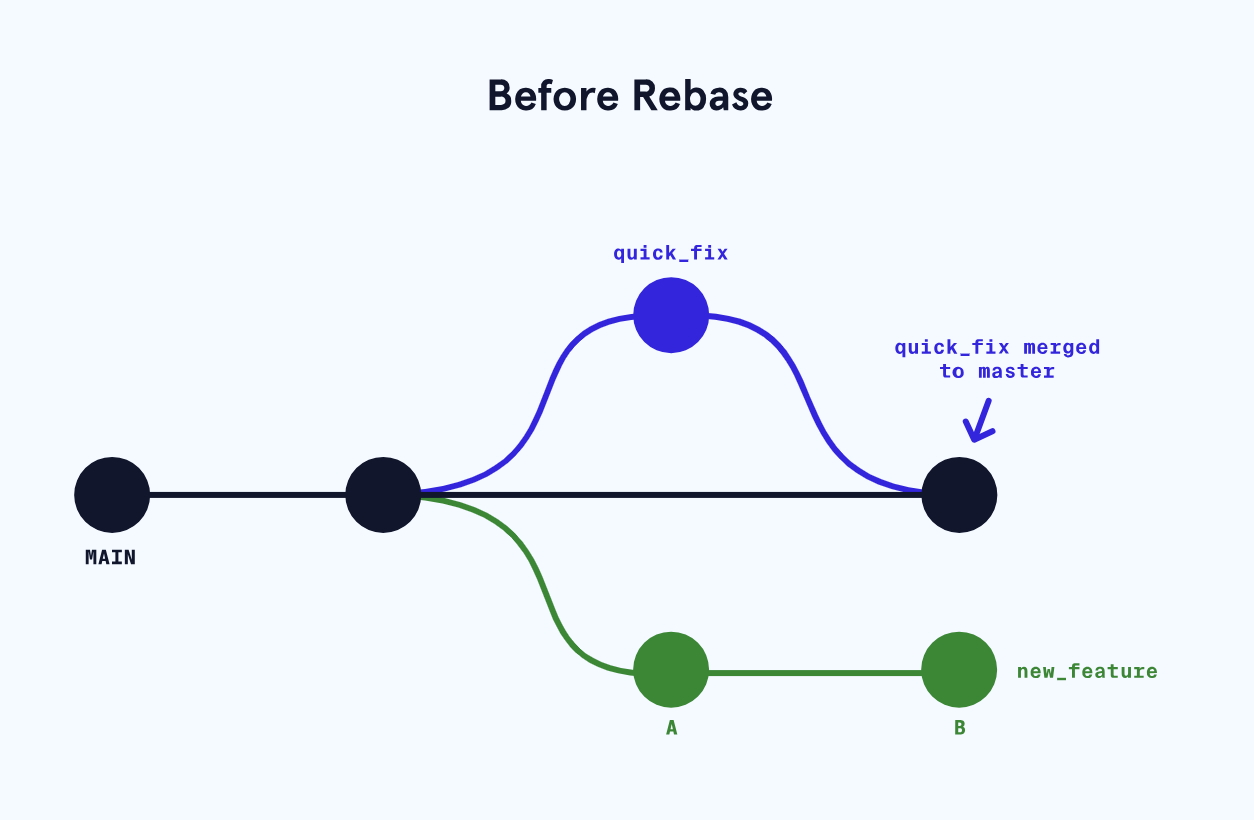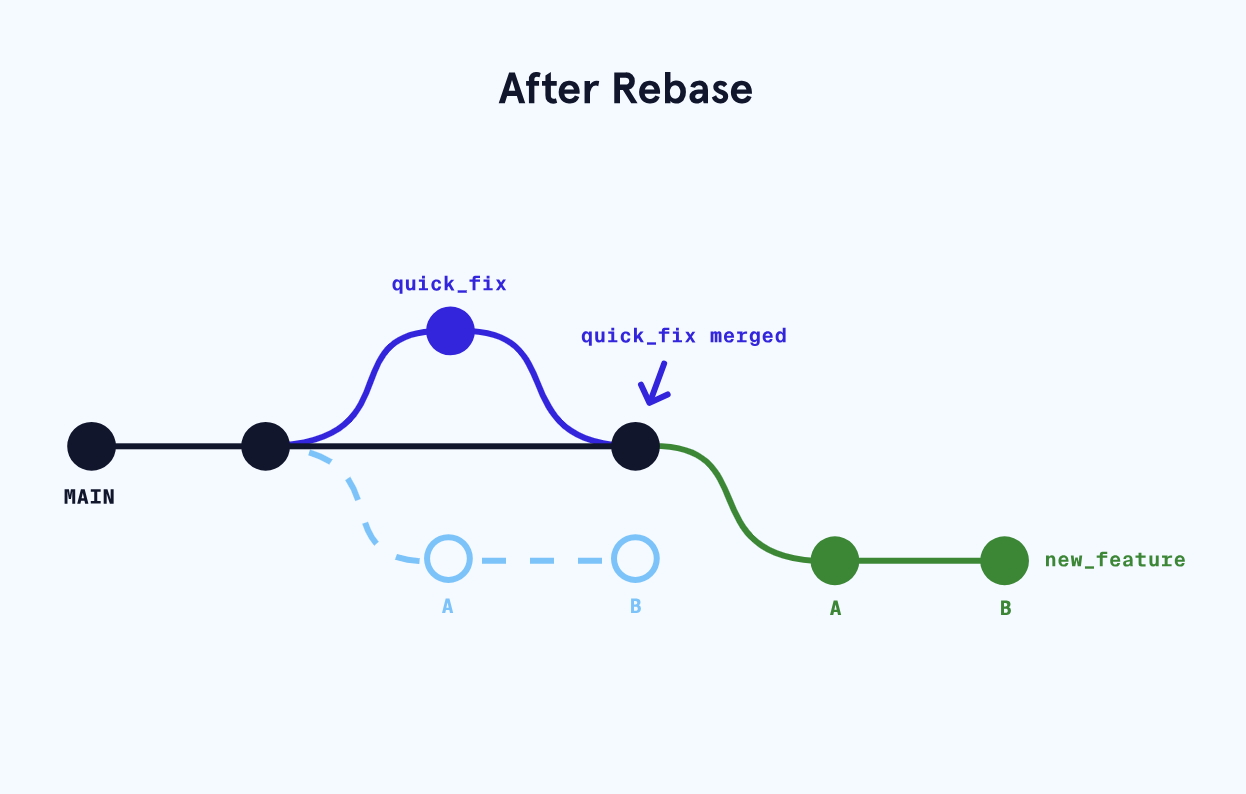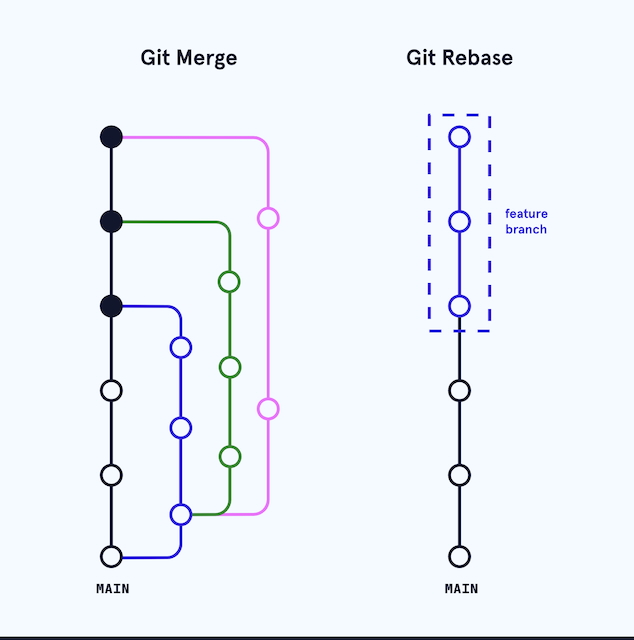Git is the industry-standard version control system that allows multiple developers to work on a project simultaneously by tracking changes and coordinating work.
GitHub cheatsheet
This is a quick reference cheat sheet for understanding and writing GitHub.
# Getting started
Introduction
# Git Flow
Branching Basics
Check which branch you're on:
git branchCreate a new branch:
git branch new_branchSwitch to it:
git checkout branch_nameMerge & Conflicts
To merge a branch into master:
git merge branch_nameIf no new commits exist on master, this is a fast-forward merge.
If a commit on master modifies the same lines as the branch, a merge conflict occurs:
CONFLICT (content): Merge conflict in resumé.txt
Automatic merge failed; fix conflicts and then commit the result.Delete branches
After merging:
git branch -d branch_nameForce delete if not merged:
git branch -D branch_nameCloning & Remotes
Clone a remote repo:
git clone remote_location clone_nameremote_location can be a URL or local path.
See remote connections:
git remote -vDownload remote changes (no merge):
git fetchMerge remote branch into local:
git merge origin/masterPush to Remote
Push local branch to origin:
git push origin <branch_name>.gitignore
Ignore files from being staged/committed.
# Windows OS file
thumbs.db
# macOS OS file
.DS_Store
# Dependency folders
node_modules/
# Configs
.envUse patterns. Comments start with #. More at: git-scm.com
Fork
Create a copy of a GitHub project to work on independently.
Repository template
Blueprint repo to quickly generate new projects with same structure/configs. Useful for teams.
Rebase
Rewrites the history of a feature branch to place it "on top" of another (usually main). Keeps history linear and avoids extra merge commits.
Use Case
You create a feature branch new_feature. Meanwhile, a teammate fixes a bug in quick_fix and merges it into main.
Now main and new_feature have diverged.
To bring changes from main into your feature branch without polluting the history:
git checkout new_feature
git rebase mainWhat Happens?
- Commits from
mainare applied first. - Then your
new_featurecommits are "replayed" one by one. - The base of your branch becomes the tip of
main.


Benefits
- Cleaner, linear history
- No unnecessary merge commits
- Easier to follow changes in
git logorgit graph
Merge vs Rebase
- Merge: Preserves exact history, includes merge commits.
- Rebase: Rewrites history, applies changes in order.

Risks of Rebase
- It’s a destructive operation: old commits are replaced with new ones.
- Do not rebase after pushing to a shared repo (can break other clones).
- Can cause multiple conflict resolutions (once per commit replayed).
Best Practices
- Use
rebaseonly on local or private branches. - Squash commits when possible to simplify history.
- Rebase frequently to avoid big conflict batches.
# Github repository
README conventions
A high‑quality README showcases your project and helps others (and your future self) understand, install, and contribute to it. Keep the README concise, up‑to‑date, and self‑explanatory to leave a professional impression.
- Project Title The name of your project, prominently displayed.
- Description Explain the project’s purpose, motivations, problem(s) solved, and key learnings.
- Features List and, if possible, illustrate unique or core features (screenshots/gifs welcome).
- How to Use Step‑by‑step install and usage instructions, including requirements.
- Technologies Enumerate frameworks, libraries, and tools used, with their roles.
- Collaborators Credit contributors with links to their GitHub profiles.
- License Specify the license so others know usage and contribution terms.
# GitHub Actions & Automated Testing
What is GitHub Actions?
GitHub Actions is a feature for creating automated workflows triggered by repository events like push, pull request, or issue creation. Workflows are defined in YAML files and run in GitHub-hosted containers.
When to Use GitHub Actions
- CI/CD: Automatically build, test, and deploy code.
- Code Reviews: Run linters or security checks on PRs.
- Notifications: Send Slack/Teams/email alerts on events.
- Dependency Updates: Automate package updates.
- Issue Labeling: Auto-assign labels or contributors.
Find templates in the Actions Marketplace.
Workflow Components
- Events: Triggers (e.g. push, pull_request), set using on
- Jobs: Groups of steps, set with jobs
- Runners: OS environment, defined via runs-on
- Steps: Individual commands inside a job
- Actions: Prebuilt or custom logic via uses or run
Tutorial 1: Automated Testing
Create: .github/workflows/unittests.yaml
name: Continuous Integration
on: [push]
jobs:
build:
runs-on: ubuntu-latest
steps:
- uses: actions/checkout@v2
- name: Set up Python
uses: actions/setup-python@v2
with:
python-version: 3.12.0
architecture: x64
- name: Install dependencies
run: pip install -r requirements.txt
- name: Run Tests
run: python -m pytestThis workflow runs on every push. It:
- Checks out the current Git branch
- Sets up Python 3.12 on Ubuntu
- Installs project dependencies
- Runs unit tests with pytest
After pushing, go to the Actions tab to view logs. A green check appears if tests pass; if not, the workflow fails and blocks pull request merging.
Tutorial 2: Basic Workflow Template
File: .github/workflows/basic.yml
# This is a basic workflow to help you get started with Actions
name: CI
# Controls when the workflow will run
on:
# Triggers the workflow on push or pull request events but only for the "main" branch
push:
branches: [ "main" ]
pull_request:
branches: [ "main" ]
# Allows you to run this workflow manually from the Actions tab
workflow_dispatch:
# A workflow run is made up of one or more jobs that can run sequentially or in parallel
jobs:
# This workflow contains a single job called "build"
build:
# The type of runner that the job will run on
runs-on: ubuntu-latest
# Steps represent a sequence of tasks that will be executed as part of the job
steps:
# Checks-out your repository under $GITHUB_WORKSPACE, so your job can access it
- uses: actions/checkout@v4
# Runs a single command using the runners shell
- name: Run a one-line script
run: echo Hello, world!
# Runs a set of commands using the runners shell
- name: Run a multi-line script
run: |
echo Add other actions to build,
echo test, and deploy your project.This workflow is triggered on push or pull request to main, or manually from GitHub UI. It:
- Checks out code using actions/checkout@v4
- Prints "Hello, world!" in one step
- Prints a multi-line message in another step